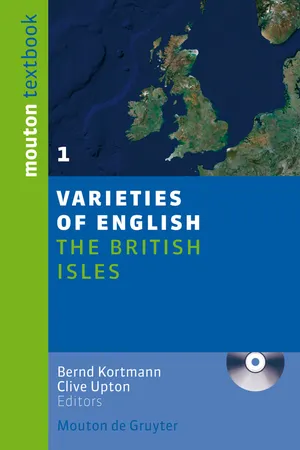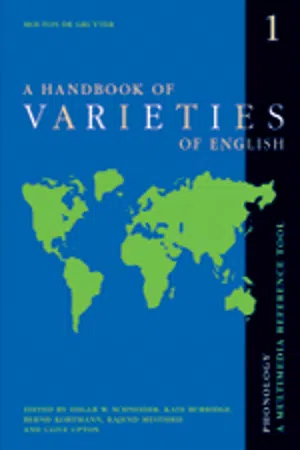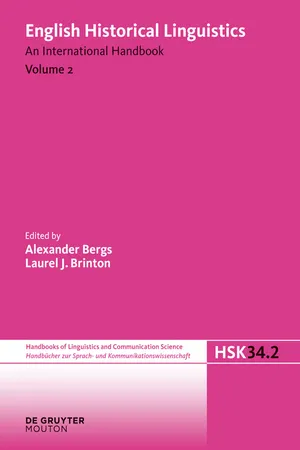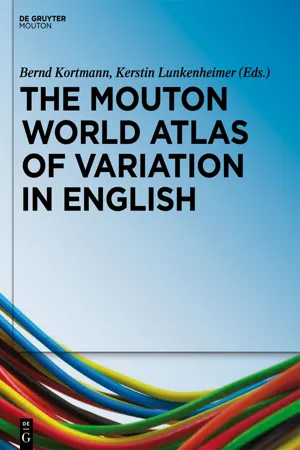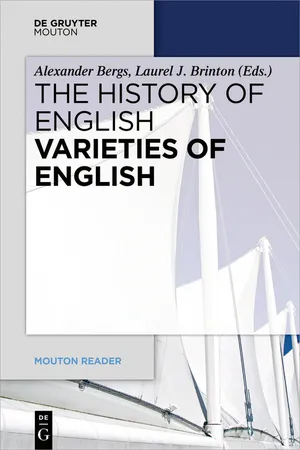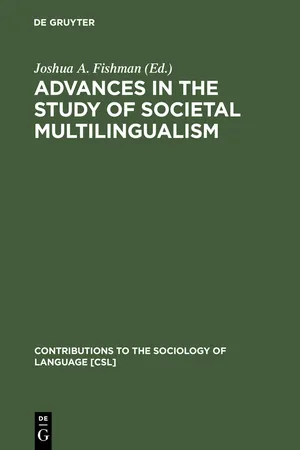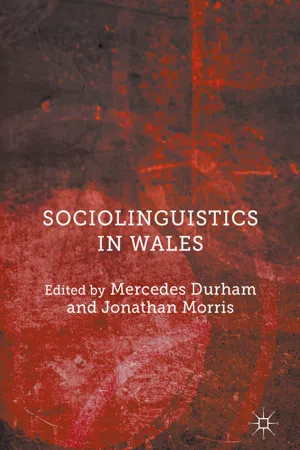Languages & Linguistics
Welsh English
Welsh English refers to the variety of English spoken in Wales, influenced by the Welsh language and its phonology, vocabulary, and grammar. It is characterized by a distinct accent and certain linguistic features that set it apart from other forms of English. Welsh English reflects the cultural and historical interactions between the Welsh and English languages within Wales.
Written by Perlego with AI-assistance
Related key terms
1 of 5
10 Key excerpts on "Welsh English"
- eBook - PDF
- Bernd Kortmann, Clive Upton, Bernd Kortmann, Clive Upton(Authors)
- 2008(Publication Date)
- De Gruyter Mouton(Publisher)
These differences are mirrored to a degree, more so in pronunciation, in spoken English. Thus Welsh English: phonology 107 it is possible to talk of two main types of Welsh English, one centred in the north-west, the other in the mid-south. In these main northern and southern sub-varieties, non-standard features tend to be derived from Welsh-language influence. But there are other determining factors, such as influence from the neighbouring non-standard dialects (rural and urban) of England, particularly but not exclusively in the border areas, south Pembrokeshire and Gower. As for the term Welsh English , it has not been the universal label of choice. At the outset of the only national survey of spoken English in Wales, David Parry chose the term Anglo-Welsh for the varieties used by elderly English-speaking Welsh people. In addition, Welsh English has the potential to arouse nationalist sensibilities. As Coupland and Thomas (1989: 2) noted: the language question in Wales is sufficiently highly charged that some might infer that even to pay analytic attention to English in Wales, or ‘Welsh English’ [...] represents an ideological position, perhaps even a form of capitulation, or collusion with the forces threatening the Welsh language. My view, briefly, is that English is a thoroughly established language of Wales, a language used by and belonging to the Welsh people – not that they have sole ownership of it, of course. My only anxiety over using the umbrella Welsh English could apply equally to other similar labels: that it masks diversity (that is, of English in Wales) and connections (between English inside and English outside Wales). 2. The phonological system The most comprehensive collection of Welsh English data is in the archives of the Survey of Anglo-Welsh Dialects (henceforth SAWD) at the Department of English, University of Wales Swansea. - eBook - PDF
A Handbook of Varieties of English
A Multimedia Reference Tool. Volume 1: Phonology. Volume 2: Morphology and Syntax
- Bernd Kortmann, Edgar W. Schneider(Authors)
- 2008(Publication Date)
- De Gruyter Mouton(Publisher)
These differences are mirrored to a degree, more so in pronunciation, in spoken English. Thus it is possible to talk of two main types of Welsh English, one centred in the north-west, the other in the mid-south. In these main northern and southern sub-varieties, non-standard features tend to be derived from Welsh-language influence. But there are other de-termining factors, such as influence from the neighbouring non-standard dialects (rural and urban) of England, particularly but not exclusively in the border areas, south Pembrokeshire and Gower. As for the term Welsh English , it has not been the universal label of choice. At the outset of the only national survey of spoken English in Wales, David Parry 100 Robert Penhallurick chose the term Anglo-Welsh for the varieties used by elderly English-speaking Welsh people. In addition, Welsh English has the potential to arouse nationalist sensibilities. As Coupland and Thomas (1989: 2) noted: the language question in Wales is sufficiently highly charged that some might infer that even to pay analytic attention to English in Wales, or ‘Welsh English’ [...] represents an ideological position, perhaps even a form of capitulation, or collusion with the forces threatening the Welsh language. My view, briefly, is that English is a thoroughly established language of Wales, a language used by and belonging to the Welsh people – not that they have sole ownership of it, of course. My only anxiety over using the umbrella Welsh Eng-lish could apply equally to other similar labels: that it masks diversity (that is, of English in Wales) and connections (between English inside and English outside Wales). 2. The phonological system The most comprehensive collection of Welsh English data is in the archives of the Survey of Anglo-Welsh Dialects (henceforth SAWD) at the Department of English, University of Wales Swansea. - eBook - PDF
- Alexander Bergs, Laurel J. Brinton, Alexander Bergs, Laurel J. Brinton(Authors)
- 2012(Publication Date)
- De Gruyter Mouton(Publisher)
However, the increasingly multicultural population, containing some 5,436 Banglade-shi, 6,500 Somali and other non-European migrants, should caution us against assuming that all other residents are comfortable in using English in public life. Wales is an increasingly multilingual society. 3 Sociolinguistic variation in Welsh English 3 . 1 Phonology Overviews of regional and social variation in English as spoken in Wales are provided by Wells (1982: 377–393) and Penhallurick (2007); see also the listings in Crystal (2003: 335). Variation in Welsh English broadly reflects historical tendencies of Angli-cization, with some eastern varieties of English being perceived as “not Welsh”, while other varieties are strongly resonant of Welsh identities. Vernacular English spoken in north-east Wales, in a zone including Rhyl, Prestatyn, Mold, and Buckley, is systemat-ically influenced by Liverpool norms, for example with affricated final /t/ and /k/ in great, like , etc., hypercorrect-sounding realizations of know, cold , etc. (where the onset to the diphthong is schwa) and north-of-England-type realizations of bath (with short /a/) and blood (with ‘uh’ rather than the wedge vowel found in Received Pronun-ciation). A much smaller zone in the extreme south-east, east of Newport, shares fea-tures with south-west (of England) speech, most notably its rhotic characteristic (pronouncing /r/ in farm, guard, first , etc.). Other longstanding English areas (cf. Aw-berry 1997: 86–88) are southern Pembrokeshire and Gower (Penhallurick 1994) where rhotic pronunciation is also found as a relic feature. The populous south-eastern conurbations of Barry, Cardiff (the capital city), and Newport developed a distinctive and again perceptibly rather “un-Welsh” vernacular variety during their rapid growth as industrial port cities. - Bernd Kortmann, Kerstin Lunkenheimer(Authors)
- 2013(Publication Date)
- De Gruyter Mouton(Publisher)
Conversely, because of the well-established nature of Welsh English, one can argue that this group nevertheless uses an L1 variety of English. There have been no monoglot Welsh speakers in Wales since at least the mid-twentieth century. From these calculations we deduce between about 2.5 to almost 3 million speakers of Welsh English. This chapter on the WAVE-listed non-standard grammatical features in Welsh English draws on an exten-sive range of sources, including material collected for the Survey of Anglo-Welsh Dialects (SAWD; see Parry (1999) and Penhallurick (1991, 1996)), and new material from the Millennium Memory Bank (MMB, 1998–1999) and the BBC Voices project (2004–2005) which permits an updated view of Welsh English gram-mar. For further details and discussion of these and the other sources see section 3 below. 2 Socio-cultural background In the twelfth century, it is thought, following Norman intrusions, communities of English speakers were planted in the Gower Peninsula and Pembroke, which to this day are known as ‘Little Englands beyond Wales’. The Vale of Glamorgan and the eastern areas along the border with England were similarly subject to early anglicization, and no doubt from this time English could also be heard in ‘scattered towns throughout Wales’ where Normans and English merchants were present (German 2009: 27). The late-fifteenth-century English-language poem Hymn to the Virgin , composed at Oxford by the Welshman Ieuan ap Hywel Swrdal using the orthography of Welsh, is suggestive of the basis of the sound-system of Welsh English (see German 2009, Dobson 1957: 2–6). But it was not until the nineteenth century that English became the dominant lan-guage in Wales in terms of speaker numbers. Davies (2000: 89) states that between 1801 and 1891 the number of English monoglots in Wales increased seven-fold, and the number of inhabitants with a knowledge of Eng-lish increased seventy-fold.- eBook - ePub
- Heli Paulasto, Rob Penhallurick, Benjamin Jones(Authors)
- 2020(Publication Date)
- De Gruyter Mouton(Publisher)
Wenglish: The Dialect of the South Wales Valleys (2008) by Robert Lewis. As the titles may indicate, neither book approaches its subject purely academically but is intended for the enlightenment and entertainment of the general public. The glossaries in the books are long and comprehensive, containing not only dialect words of Welsh and English origin, but also expressions and idioms, nonstandard grammar items and regionally distinctive pronunciations of specific words. As such, they offer an interesting window into the dialect of the Valleys, coloured by the region’s bilingual past as an industrial hotspot. Both Edwards and Lewis are local to the area, which is an advantage but also a problem, as they base their glossaries and descriptions on their own knowledge and experience of the dialect rather than systematic data collection or corpus evidence: no further references or sources of information are given. The glossaries are also uninformative on the frequencies and time frames of the words, and thus it is likely that there is a great deal of quantitative, regional and diachronic variation in their actual use. The authors do not contextualize “Wenglish” or its features as part of English in Wales more generally but present it as an independent development.Welsh English Dialect (Jones 2016a) is likewise intended for a wide audience, and although concise, it is more systematic in its approach and regionally comprehensive. Besides a general word list, the booklet includes lexical case studies and thematic sections on, for example, the language of children’s games, food, work, music, and the home, as well as WelE phraseology.WelE dialect lexicon has recently been charted alongside EngE dialects, in the BBC Voices project (BBC Voices 2014) through an online “Language Lab” survey and a radio survey (2004–2005; see Penhallurick 2013). The Language Lab results are available in the form of lexical maps at the BBC Voices website. The Voices radio survey, in turn, involved groups of informants who were gathered together to discuss the topic of dialects and accents in various parts of the country. They were furthermore presented with a list of lexical items, and the outcomes of the discussions have been worked into linguistic commentaries which are availed of in the present description (see Section 1.6 and Chapter 6). The Voices - eBook - ePub
- Alexander Bergs, Laurel Brinton, Alexander Bergs, Laurel Brinton(Authors)
- 2017(Publication Date)
- De Gruyter Mouton(Publisher)
per se . In her consideration of the field, Löffler (2008) has cautioned that although the “Welsh Englishes” are an acknowledged feature of the sociolinguistic situation in Wales, their social role is neither clear-cut nor simple.Borrowings from Welsh into English from the 17th century onwards relate mainly to aspects of Welsh culture and an illustrative list will suffice here. They include tad or dad , father; cromlech an ‘arched stone’ a megalithic chamber tomb or dolmen; englyn , a four-lined stanza of prescribed from written in cynghanedd metre; flummery , a pudding made with coagulated wheatflour or oatmeal, which has come to mean flattery or nonsense; Gorsedd , a ‘throne’ a meeting of bards and druids; cynghannedd , a complex form of alliterative metre; cwm , a valley; a deep rounded hollow with a steep side formed by ice action; a cirque; eisteddfod , ‘session’ a festival of poetry, singing, music the arts and increasingly technology; hwyl , emotional fervor, characteristic of poetry recitation, and corgi , ‘dwarf-dog’ short-legged dogs from either Cardigan or Pembroke as favored by the British Royal Family (Helcion 1998).Finally, it is important not to over-compartmentalize Welsh and English in Wales, because code-switching is a common characteristic of bilingual usage. Research by Deuchar (2006) and Deuchar et al. (2007, 2016, 2017) for example, has evaluated universal and conditional models of code switching. Stammers and Deuchar (2007) have analyzed English verbs in Welsh speech by reference to generic hypotheses suggested by Poplack and Meechan (1998) and Myers-Scotton (1993) and concluded that frequency may be more important than contrast between switches and loans. Deuchar (2006) also argues that Welsh-English speakers in her data tend to maintain a Welsh-language matrix in their code-switched speech, and consequently that they are comparable to Spanish-English speakers in the USA, or Arabic-Dutch speakers in the Netherlands. This in turn suggests a pattern of bilingual communication typical of relatively stable bilingual contexts, rather than one that presages language shift or language death. Musk (2010) takes a different perspective, providing evidence that Welsh-English bilinguals tend to blend their codes into a relatively syncretic and flexible communication system. Codes are kept separate only for specific discursive purposes, such as quoting other people’s utterances. - Joshua A. Fishman(Author)
- 2014(Publication Date)
- De Gruyter Mouton(Publisher)
5.4.2. Lexis It is on the level of vocabulary that the English influence is most radical and extensive. In those domains where the Welsh language is infrequently employed English words have displaced the native vocabulary or made the development of new Welsh words unlikely. English, or international terminology borrowed through English, prevails in the sciences and in industry. This is the case not only in those areas of technological activity which are of recent growth such as electronics and precision engineering, for instance, but in the traditional industries and crafts of Wales such as agriculture and the country crafts. Whenever a craft dies out or an occupation disappears part of the language dies with it. The terminology of the industries characteristic of South Wales after the industrial revolution are almost exclusively English, for instance, in mining bedin 'heading', ffas 'face', siafft 'shaft', lefel 'level'; and in steelmaking rowl twrner 'roll turner', ffwrnesman 'furnace man'. The Welsh names of herbs Migration and the decline of the Welsh language 337 and the vocabulary of nature in general is rapidly disappearing in colloquial Welsh and is kept alive only by the efforts of the schools and the special programs broadcast by the BBC. The Welsh names are replaced by straightforward borrowings or translations. An instance of the latter is the name of the fungus Earth Star now only known by its recent label seren ddaear, a literal translation of the English. It is seldom that the Welsh names of plants, grasses, flowers, and animals are known or used by the children of South Wales. Very frequently the experts included in programs for radio listeners, when they deal with topics such as gardening, have to add the English names of plants, herbs, animals, and fruits.- eBook - ePub
- Mercedes Durham, Jonathan Morris, Mercedes Durham, Jonathan Morris(Authors)
- 2017(Publication Date)
- Palgrave Macmillan(Publisher)
Journal of Sociolinguistics 11(1): 74–103.CrossRefCoupland, Nikolas, Angie Williams, and Peter Garrett. 1994. The social meanings of Welsh English: Teachers’ stereotyped judgements. Journal of Multilingual and Multicultural Development 15(6): 471–489. doi:10.1080/01434632.1994.9994585 .———. 1999. ‘Welshness’ and ‘Englishness’ as attitudinal dimensions of English language varieties in Wales. In Handbook of perceptual dialectology , vol 1, ed. Dennis R. Preston, 333–343. Amsterdam: John Benjamins.Cramer, Jennifer. 2010. The effect of borders on the linguistic production and perception of regional identity in Louisville, Kentucky. Unpublished PhD thesis, Urbana: University of Illinois at Urbana-Champaign. https://www.ideals.illinois.edu/bitstream/handle/2142/18426/Cramer_Jennifer.pdf?sequence=1Cukor-Avila, Patricia, Lisa Jeon, Patricia C. Rector, Chetan Tiwari and Zak Shelton. 2012. ‘Texas – It’s like a whole nuther country’: Mapping Texans’ perceptions of dialect variation in the Lone Star State. In Proceedings of the Twentieth Annual Symposium About Language and Society , 55: 10–19. Austin, TX.Davies, John. 2007. A history of Wales . London: Penguin.Department for Children, Education, Lifelong Learning and Skills. 2007. Defining schools according to Welsh medium provision . Cardiff: Welsh Assembly Government. http://gov.wales/topics/educationandskills/publications/guidance/defining-schools-welsh-medium/?lang=enDiercks, Willy. 2002. Mental maps: Linguistic geographic concepts. In Handbook of perceptual dialectology , ed. Daniel Long, and Dennis R. Preston, 51–70. Amsterdam: John Benjamins.Edwards, John. 2003. “Talk Tidy”: The art of speaking Wenglish . Creigiau: Tidyprint Publications. (First published in 1985, Cowbridge: Brown Books).Fought, Carmen. 2002. Californian students’ perceptions of, you know, regions and dialects? In Handbook of perceptual dialectology - A. Judge(Author)
- 2007(Publication Date)
- Palgrave Macmillan(Publisher)
This brings in the whole problem of what it is to be Welsh. Those who feel that Welshness is defined by the language 22 wish to slow down the in-migration from England, by monitoring, for example, the purchase of houses in Wales, and only allowing this to happen where the Anglophone expresses a willingness to learn Welsh (which some do). There have also been complaints that English people retiring in Wales are a weight on the community. This kind of statement, associated with Plaid Cymru, has brought accusations of racialism against the English. This is true, but, on the other hand, the only way to save Welsh is for the whole population, including the Anglophones, to become bilingual. The accusation of racism can clearly be countered by that of respect for your host’s culture. (Except that some English speakers see Wales as a mere extension of England. Clearly the debate is never ending.) The problem for the language is that not all Welsh people feel that to be Welsh you have to speak the language. Some castigate those who create jobs for which a knowledge of Welsh is necessary, protesting that this is blackmail. The writer Byron Rogers, for example, maintains that 174 Linguistic Policies and the Survival of Regional Languages in France and Britain such policies exclude the vast majority from these jobs, and that just as a similar majority used to be dispossessed for lack of fluency in English, the same is happening again the other way round. He concludes ‘Dispossession in our own country is for us a very old experience, it is just that in its time it has taken many forms’ (Rogers 2003: xiv). He thus fulfils Saunders Lewis’ prophecy, made in 1962 in a famous radio broad- cast. He stated that the way things were going, Welsh would be dead by the twenty-first century, unless it became an official state language, used in all public domains.- eBook - PDF
Semiotic Landscapes
Language, Image, Space
- Adam Jaworski, Crispin Thurlow(Authors)
- 2010(Publication Date)
- Continuum(Publisher)
But the question remains of what particular quality of bilingualism is being aspired to. Bilingualism is realized in different societies in very different ways. Two (or more) languages can exist in conditions where most members of the community are competent speakers of both languages, or where very few of them are. Welsh Linguistic Landscapes 85 Status can be distributed evenly or entirely unevenly between languages and language groups, as in diglossic communities, as they were originally character-ized by Charles Ferguson (1996). Wales was diglossic in the period when English was the ‘high’ variety, functionally specified as the language used in formal education and in business, with Welsh tending to be relegated to ‘low’ functions including use in family (but also religious) domains, and so on. Sociolinguistic accounts of bilingual situations inevitably document functional non-equivalences between languages – where particular languages fit into par-ticular societal niches. Against this backdrop it is striking to find bilingualism being ideologized and aspired to as a sociolinguistic arrangement involving full equivalence between languages, and this is what we find in the Welsh Assembly Government’s policy documents. A principle of sociolinguistic equivalence was written into the 1993 Welsh Language Act. As we saw earlier, the Act placed a duty on the public sector to treat Welsh and English ‘on an equal basis’. The ideology of equivalence reaches deep into planners’ basic understanding of bilingualism, and into their specifi-cation of targeted outcomes. This is a laudable aim, even though sociolinguistic research suggests it is quite unlikely to be unattainable. Ironically enough, Iaith Pawb, the key policy document of the Welsh Assembly Government, has the Welsh title on the English version of the document without translation. But it is adamant about the importance of linguistic equivalence, as the following extracts show.
Index pages curate the most relevant extracts from our library of academic textbooks. They’ve been created using an in-house natural language model (NLM), each adding context and meaning to key research topics.
